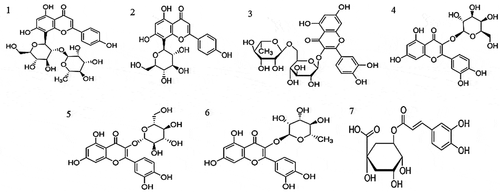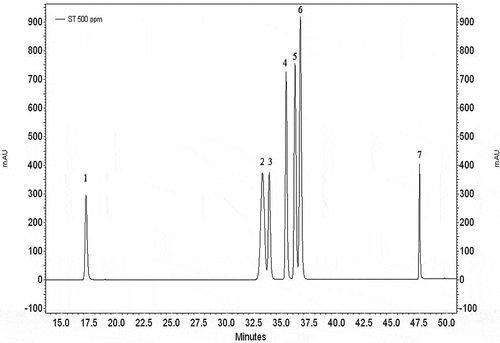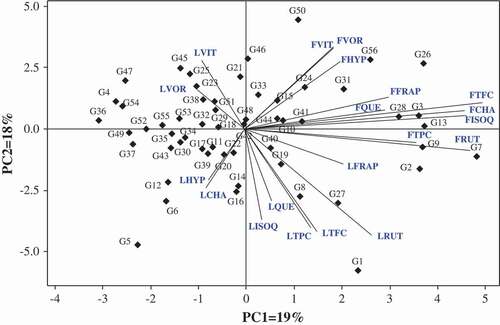Figures & data
Figure 1. Structures of the main phenolic compounds identified in hawthorn; vitexin (1), vitexin 2”-O-rhamnoside (2), rutin (3), hyperoside (4), isoquercetin (5), quercetin (6), and chlorogenic acid (7).

Table 1. Sampling locations of the different Crataegus specimens studied.
Table 2. Levels of total phenolic content, total flavonoids, and antioxidant activity in flowers and leaves of different hawthorn (Crataegus spp.) species.
Table 3. Content of phenolic compounds in the leaves of different hawthorn (Crataegus spp.) species.
Table 4. Content of phenolic compounds in the flowers of different hawthorn (Crataegus spp.) species.
Figure 2. HPLC chromatograms of seven phenolic standards (1. chlorogenic acid, 2. vitexin 2”-O-rhamnoside, 3. vitexin, 4. rutin, 5. hyperoside, 6. isoquercetin, and 7. quercetin).

Figure 3. Principal component analysis (PCA) of hawthorn species based on the 20 traits. (FTPC, flower total phenolic content; LTPC, leaf total phenolic content; FTFC, flower total flavonoid content; LTFC, leaf total flavonoid content; FFRAP, flower ferric-reducing antioxidant power; LFRAP, leaf ferric-reducing antioxidant power; FCHA, flower chlorogenic acid; FVOR, flower vitexin 2”-O-rhamnoside; FVIT, flower vitexin; FRUT, flower rutin; FHYP, flower hyperoside; FISOQ, flower isoquercetin; FQUE, flower quercitrin; LCHA, leaf chlorogenic acid; LVOR, leaf vitexin 2”-O-rhamnoside; LVIT, leaf vitexin; LRUT, leaf rutin; LHYP, leaf hyperoside; LISOQ, leaf isoquercetin; and LQUE, leaf quercitrin).

Table 5. Correlation coefficients between total phenolic and flavonoid contents, antioxidant activity, and phenolic compounds on the studied hawthorn (Crataegus spp.) species.
